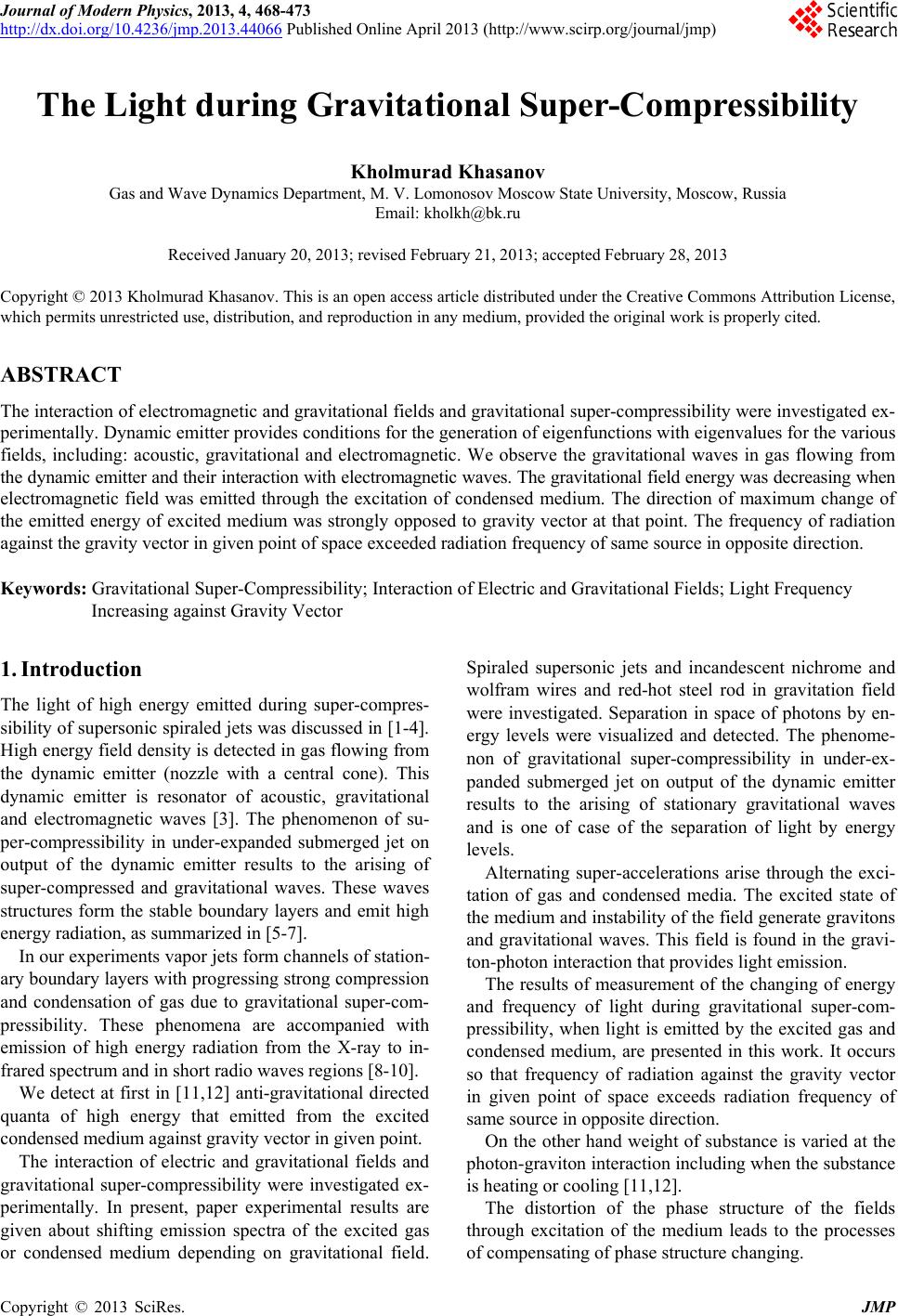
Journal of Modern Physics, 2013, 4, 468-473
http://dx.doi.org/10.4236/jmp.2013.44066 Published Online April 2013 (http://www.scirp.org/journal/jmp)
The Light during Gravitational Super-Compressibility
Kholmurad Khasanov
Gas and Wave Dynamics Department, M. V. Lomonosov Moscow State University, Moscow, Russia
Email: kholkh@bk.ru
Received January 20, 2013; revised February 21, 2013; accepted February 28, 2013
Copyright © 2013 Kholmurad Khasanov. This is an open access article distributed under the Creative Commons Attribution License,
which permits unrestricted use, distribution, and reproduction in any medium, provided the original work is properly cited.
ABSTRACT
The interaction of electromagnetic and gravitational fields and gravitational super-compressibility were investigated ex-
perimentally. Dynamic emitter provides conditions for the generation of eigenfunctions with eigenvalues for the various
fields, including: acoustic, gravitational and electromagnetic. We observe the gravitational waves in gas flowing from
the dynamic emitter and their interaction with electromagnetic waves. The gravitational field energy was decreasing when
electromagnetic field was emitted through the excitation of condensed medium. The direction of maximum change of
the emitted energy of excited medium was strongly opposed to gravity vector at that point. The frequency of radiation
against the gravity vector in given point of space exceeded radiation frequency of same source in opposite direction.
Keywords: Gravitational Super-Compressibility; Interaction of Electric and Gravitational Fields; Light Frequency
Increasing against Gravity Vector
1. Introduction
The light of high energy emitted during super-compres-
sibility of supersonic spiraled jets was discussed in [1-4].
High energy field density is detected in gas flowing from
the dynamic emitter (nozzle with a central cone). This
dynamic emitter is resonator of acoustic, gravitational
and electromagnetic waves [3]. The phenomenon of su-
per-compressibility in under-expanded submerged jet on
output of the dynamic emitter results to the arising of
super-compressed and gravitational waves. These waves
structures form the stable boundary layers and emit high
energy radiation, as summarized in [5-7].
In our experiments vapor jets form channels of station-
ary boundary layers with progressing strong compression
and condensation of gas due to gravitational super-com-
pressibility. These phenomena are accompanied with
emission of high energy radiation from the X-ray to in-
frared spectrum and in short radio waves regions [8-10].
We detect at first in [11,12] anti-gravitational directed
quanta of high energy that emitted from the excited
condensed medium against gravity vector in given point.
The interaction of electric and gravitational fields and
gravitational super-compressibility were investigated ex-
perimentally. In present, paper experimental results are
given about shifting emission spectra of the excited gas
or condensed medium depending on gravitational field.
Spiraled supersonic jets and incandescent nichrome and
wolfram wires and red-hot steel rod in gravitation field
were investigated. Separation in space of photons by en-
ergy levels were visualized and detected. The phenome-
non of gravitational super-compressibility in under-ex-
panded submerged jet on output of the dynamic emitter
results to the arising of stationary gravitational waves
and is one of case of the separation of light by energy
levels.
Alternating super-accelerations arise through the exci-
tation of gas and condensed media. The excited state of
the medium and instability of the field generate gravitons
and gravitational waves. This field is found in the gravi-
ton-photon interaction that provides light emission.
The results of measurement of the changing of energy
and frequency of light during gravitational super-com-
pressibility, when light is emitted by the excited gas and
condensed medium, are presented in this work. It occurs
so that frequency of radiation against the gravity vector
in given point of space exceeds radiation frequency of
same source in opposite direction.
On the other hand weight of substance is varied at the
photon-graviton interaction including when the substance
is heating or cooling [11,12].
The distortion of the phase structure of the fields
through excitation of the medium leads to the processes
of compensating of phase structure changing.
C
opyright © 2013 SciRes. JMP